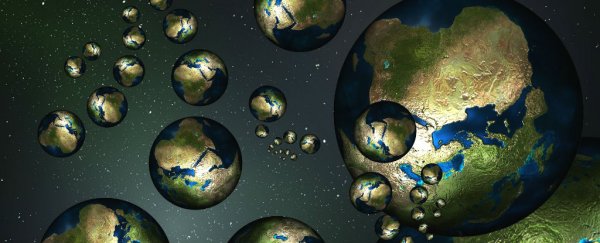If you consider that the Milky Way galaxy has a radius of 100,000 light-years (1 light-year is 9.5 trillion km), and it's estimated that there are 100 to 200 billion galaxies in the Universe, we're living in an unfathomably gigantic place.
But what if this was just a fraction of what's truly out there? What if our Universe is just one of many, and they're all bouncing off of each other like mind-numbingly gargantuan marbles, each with their own weird laws of physics?
Welcome to the multiverse, where our Universe could be just one of the infinite numbers of universes that were spawned by the Big Bang.
As the latest episode of Life Noggin explains, it's widely believed that a mere fraction a second after the Big Bang, our Universe expanded incredibly quickly - a period known as inflation - and then stopped.
It's been expanding ever since, but nowhere near as fast.
And there's reason to believe that there could be pockets of space out there that never stopped inflating after the Big Bang, and some others that have, but at different stages in their lifetime.
This is known as the eternal inflation hypothesis in which each of these bubbles of space represent entirely different universes, entirely separated from our own.
And here's where things get really interesting, because there's nothing to say that these hypothetical universes have to follow the same laws of physics or the fundamental constants that make our Universe what it is today.
So what would that even look like?
Well, the bad news is the answer for most of these universes could be "not much", because all it takes is a tiny tweak for the fabric of our existence to fall apart, so what are the chances that every Universe is going to get a winning combo?
As Fraser Cain from Universe Today explains, "For each one of these basic constants, it's as if the laws of physics randomly rolled the dice, and came up with our Universe. Maybe in another universe, the force of gravity is repulsive, or green, or spawns unicorns."
And that's if you're lucky. What if the forces between particles were too weak, and the atoms that make up all matter in our Universe never got the chance to form in another one?
But if we're considering that there could be infinite parallel universes out there, then maybe we have a monkey-typewriter situation on our hands, which means, statistically speaking, there could be a universe where time flows backwards, or a universe that contains another you, but ever-so-slightly skewed.
(We're really just hoping for that gravitational force of unicorns, though.)
This might all sound frustratingly abstract, but here's the thing: it might actually be possible to detect parallel universes, if they've bumped into our own Universe and left 'bruises' behind in the cosmic microwave background - the faint afterglow of the Big Bang.
I'll let the episode of Life Noggin above explain that one to you, but let's just say proving that parallel universes exist is a whole lot easier said than done.
And if you can't get enough of the multiverse, here's Fraser Cain on the brain-bending question: If the Universe is expanding, what's it expanding into?
